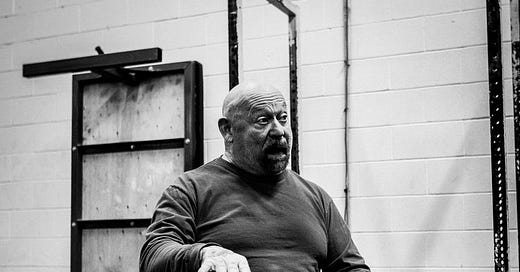Free Lunch: The 90% That Matters
Questions Explored: Do you need endurance to train intensity? Can you train intensity indefinitely? Can you shortcut endurance?
Everybody wants a shortcut. Industrialization, technology, efficiency, “biohacking”; there must be some undiscovered secret out there, right? Combine this thinking with logical fallacies of appeals to authority, emotion, and reason, and we’ve got a recipe for a lifetime of unmemorable mediocrity.
"Orthodoxy is the death of intelligence." ~ Bertrand Russell
I posted an Instagram clip commenting on the disillusionment of high-intensity training and recapping my thoughts on “Barbells and Bell Curves.”
My reflection drew a “like” from the original clip creator, whilst a prominent carnivore personality declared my statements “demonstrably false.” I suggested the commenter and original poster have formal discussion for all to benefit from. Of course, that wasn’t responded to.
What I’d like to do here is “demonstrate” the truthfulness of the premise(s) I outlined there. But first, let’s flash back to 2018. I’ve referred to Climb Strong before because good coaching and training principles transcend sport specificity.
Their article titled “The 90% That Matters” reminds us how tempting it is to be distracted by the minutia. For example, last Tuesday was supposed to be my “hard” gym day. I fell flat on my face 2:30 into a the first of 3 scheduled 6 minute rounds.
After a short temper tantrum my mind rattled through a dozen possible excuses:
Did I get enough sleep?
Was it good sleep?
Too much caffeine, not enough?
More salt?
Do I need a different supplement?
Is this because of the weight cut?
WTF is wrong with me?
Did I just give up?
You get the idea…
All of those things have some validity, they just aren’t necessarily accurate. They are examples of focusing on “the 10% that doesn’t matter”, at least probably not right now.
Maybe you don’t need a more complicated rep / set scheme, fasting protocols, supplement regimes, or parasite and heavy metal detoxes. Maybe you just need to do the work you’re avoiding.
Demonstrating My “Demonstrably False” Ideas:
Let’s set the stage by clarifying that everything we do in the gym / dojo is just “role play.” What the hell difference does it make (other than dick swinging and chest pounding) to reinvent the wheel (insert a contrived, but original circuit) faster than someone else?
I’m sure that the dissenter that inspired this article would refer to himself as an academic and thus be prone rationalizing his perspectives by saying; “the research says X.” I’d like to offer counter-examples in the vein of “world class performers are doing Y.”
World-class athletes are out winning, not being studied in university laboratories. Requiring a peer-reviewed longitudinal study to validate every training method before attempting it is the definition of pedantic.
Short-cutting Endurance?
Simply put, there’s no such thing as a free lunch. I was once one of those that I now refer to as “lifetime intermediates.” I continued to limit myself to “what the science says.” I was inspired by the pursuit of confirmation bias so that I could avoid doing the (hard) things I needed — in this case endurance work.
A further example is shown in the heart rate log featured in my “20 Miles in Hell” post:
The longest effort I had attempted prior to this (6-hour) Space Race was about two hours. Do you notice anything particular about the above graph around the 2-hour (8:00 - 10:00) mark?
I’m using examples of 2 and 6 hours here, but the point scales to whatever volume you’d like. If your longest effort has only ever been 5 second sprints, 1,600m (1 mile) probably feels like “endurance”; except Olympians are literally trying to sprint that — the world record being well under 5 minutes.
Arguing for Intensity:
The above hopefully refutes the idea that there is a “quick-and-easy” way to achieve “long-and-difficult” (i.e. enduring). However, the question at hand is really:
“Does intensity require an enduring / voluminous foundation?”
Westside Barbell (home of the legendary Louie Simmons) has set about 140 world records in power lifting (squat, bench press, and dead lift). When a single team sets 140 world records, they’re probably worth paying attention to.
Such a gym probably knows a thing or two about intensity given that 1RMs are single contractions lasting less than 30 seconds. Surely, these folks wouldn’t have you doing 60 yard sled drags or sets to failure, right?
Let’s take another example, professional MMA, since fighting is pretty intense. Professional fighters compete in 3 x 5 minute or 5 x 5 minute rounds, so they probably never do long distance / steady state conditioning, right?
Literally every elite fighter on the planet, in any discipline, still does “road work” — in addition to sprints, lifting, and circuits. Why? If the “the science is settled”, why do the first class of world class waste their time on something “demonstrably false?” Haven’t the geniuses at UFC and OTC read “the science?” Don’t they know there’s a quicker, easier, better way?
Do the Quick Thing:
HIIT makes you sweaty, looks good on social media, and feels like you worked hard. But, here’s a quick question:
Before Westside Barbell set those 100+ world records, how many reps of dead lifts, bench presses, and squats do you think each competitor did?
I don’t know the answer, but I can tell you it was probably nearing 4-digits, literally. Likewise, do world-class sprinters only run their race length (e.g. 100m)? No. In addition, how many 100m reps do you think that sprinter holding a gold medal has done in his lifetime? Notice a trend? Volume builds intensity.
By all means, do the circuits. Do the sprints. Explore and see where intensity leads, where it fails, and know that it always ends. By definition you cannot sustain maximal output indefinitely, lest you have no conception of what “maximal” actually means.
At some point the “maximum” you’re capable of today gets further from the maximum you’re capable of on your best day. By trying to “go hard all the time” you effectively just make yourself more tired, grinding into oblivion with diminishing returns. But hey, at least your methods are “science-based.”
Do the Hard Thing:
Let’s use a grappling example. Everyone says it takes 7 - 12 years to earn a black belt in BJJ, but you’re special right? You’ve found some secret on YouTube that no-one else knows, and the Disney movies of your childhood have convinced you you’ll do it in 5 years.
You can do it in 5 years; it’s been done before. But, you’ll still pay in hours. So, before you tell anyone “you’re willing to do anything to get it done” consider what life will be like in a low-budget apartment, dining on Ramen Noodles, not having a family, not owning a TV, and other things that would otherwise demand that valuable time you’ll be paying.
Back to fitness…
Essentially all recovery systems are dependent on aerobic factors. That means that even if you’re a power lifter, you need some “endurance.” Though, what that may mean for you is that if you’re spent after a single set for the day (or one training session / week), that’s not a very productive pattern.
Spoiler, you get stronger when you recover, not while you’re working.
I could dress up on YouTube and play the role of a heel too. I could also ride an assault bike hard enough to puke or shit myself in 10 minutes — the later has already been done, twice.
The irony is that that one can “condition” themselves to almost any training stimulus. However, you may be spending 90% of your time on the things that only deliver 10% of the adaptation.
Do the hard thing(s). Do the 90% that matters and results will come. Don’t wait for the “research” or anyone else’s approval. There are already badasses out there doing what lab rats will only ever dream of.
When unsure which, the 90 or the 10, you’re currently fixated on ask yourself:
Is this a fixation on the process or the outcome?
In our examples today, outcomes can greatly be aided by pharmacology and supported by “science.” However, processes don’t lie and they always deliver, just not always what you’re expecting or what your identity has attached itself to.
#webuildmachines #defendanalog






